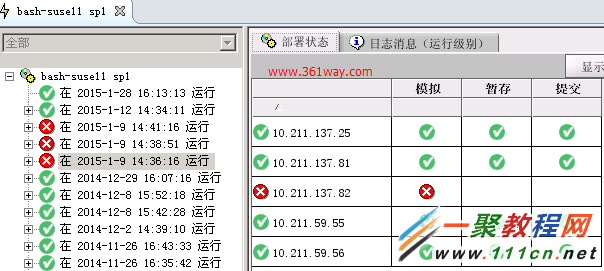深入分析bmc nsh下nexec runcmd和runscript指令使用例子
BMC软件公司[NYSE:BMC],是全球领先的云计算和IT管理解决方案提供商,其提供成套的应用解决方案,这里主要介绍的是BladeLogic Server Automation Suite下的几个指令。该软件实现的功能和saltstack、puppet等类似,用于服务器的自动化管理和批量操作。其相对于开源软件的优点是稳定、直观,缺点是源代码不公开(尽管提供了一些接口)。
一、单机普通指令执行
可以通过在安装有控制端软件的主机上通过cmd下执行nsh进入bmc network shell 界面,也可以通过在开始--程序中找到bmc network shell 并执行。这里以cmd下为例
| 代码如下 | 复制代码 |
|
C:/Documents and Settings/Administrator>nsh |
|
二、runcmd和runscript
当需要在多台主机上执行指令时,可以通过runcmd和runscript执行,具体如下:
1、runcmd
| 代码如下 | 复制代码 |
| CMBBSA% runcmd -h 10.212.52.252 10.212.52.253 -e uptime ==> 10.212.52.252 16:50pm up 7:24, 1 user, load average: 0.20, 0.30, 0.28 ==> 10.212.52.253 cd: no route to host: //10.212.52.253/ |
|
由于后面一台主机未安装client纳管,所以会报没有route到主机。也可以通过-f参数指定主机列表、通过redi指令将结果输出到文件。
| 代码如下 | 复制代码 |
| 10% runcmd -f //@/C/361way/hosts.txt -e uptime |redi //@/C/361way/uptime.txt |
|
注://@指本机,这里也可以通过//IP指向一台被纳管主机;hosts.txt是主机列表,每行一个IP或每行一个主机名;redi 也可以输出到每纳管主机的一个分区,由于这里管理软件装在windows主机上,//@/C,指本机的c盘下的361way目录,当然也可以指定一台被纳管的linux,如:redi ///10.212.52.253/opt/361way/uptime.txt 。
2、runscript
其用法和runcmd基本一样,只不过其-e指定的是一个脚本,示例:
| 代码如下 | 复制代码 |
| CMBBSA% runscript -f //@/C/361way/hosts.txt -e //@/C/361way/ifconfig.sh ==> 10.212.52.252 eth0 Link encap:Ethernet HWaddr 00:50:56:A8:65:7E inet addr:10.212.52.252 Bcast:10.212.52.255 Mask:255.255.255.0 inet6 addr: fe80::250:56ff:fea8:657e/64 Scope:Link UP BROADCAST RUNNING MULTICAST MTU:1500 Metric:1 RX packets:83773 errors:0 dropped:9093 overruns:0 frame:0 TX packets:9869 errors:0 dropped:0 overruns:0 carrier:0 collisions:0 txqueuelen:1000 RX bytes:23426732 (22.3 Mb) TX bytes:1292499 (1.2 Mb) lo Link encap:Local Loopback inet addr:127.0.0.1 Mask:255.0.0.0 inet6 addr: ::1/128 Scope:Host UP LOOPBACK RUNNING MTU:16436 Metric:1 RX packets:38330 errors:0 dropped:0 overruns:0 frame:0 TX packets:38330 errors:0 dropped:0 overruns:0 carrier:0 collisions:0 txqueuelen:0 RX bytes:2935885 (2.7 Mb) TX bytes:2935885 (2.7 Mb) ==> 10.211.160.211 eth0 Link encap:Ethernet HWaddr 00:50:56:9C:1B:00 inet addr:10.211.160.211 Bcast:10.211.160.255 Mask:255.255.255.0 inet6 addr: fe80::250:56ff:fe9c:1b00/64 Scope:Link UP BROADCAST RUNNING MULTICAST MTU:1500 Metric:1 RX packets:4940145 errors:0 dropped:103704 overruns:0 frame:0 TX packets:946952 errors:0 dropped:0 overruns:0 carrier:0 collisions:0 txqueuelen:1000 RX bytes:2195897939 (2094.1 Mb) TX bytes:97687372 (93.1 Mb) lo Link encap:Local Loopback inet addr:127.0.0.1 Mask:255.0.0.0 inet6 addr: ::1/128 Scope:Host UP LOOPBACK RUNNING MTU:16436 Metric:1 RX packets:156694 errors:0 dropped:0 overruns:0 frame:0 TX packets:156694 errors:0 dropped:0 overruns:0 carrier:0 collisions:0 txqueuelen:0 RX bytes:12128544 (11.5 Mb) TX bytes:12128544 (11.5 Mb) |
|
hosts.txt和ifconfig.sh文件的内容为:
| 代码如下 | 复制代码 |
|
# hosts.txt文件 |
|
3、runcmd的帮助
| 代码如下 | 复制代码 |
|
CMBBSA% man runcmd |
|
三、nexec
先看下nexec的man帮助
| 代码如下 | 复制代码 |
| CMBBSA% man nexec nexec(1) nexec(1) NAME nexec - Engine to interface remote commands. SYNOPSIS nexec [-?] [-t term] [-o] [-i] [-l] [-nohup hostname "cmd &"] -e | hostname cmd [args] DESCRIPTION The nexec program works in one of two ways. If the program is called explicitly, it uses the syntax nexec ARG1 ARG2. The first argument is either the name of the host on which the specified command should be executed or the command option -e, which indicates that the command should be executed on the current remote host, as determined by the current working directory. The remaining arguments arels nex the name and arguments of the remote program to be executed. The other way to call the nexec program is by calling a command that is implicitly linked to the nexec program. Invoking a command that is linked to nexec automatically translates the command from nexec CMBBSA% |
|
直接看这段帮助信息可能有点懵懂,这里给个示例看下runcmd与nexec的区别
| 代码如下 | 复制代码 |
| 10% runcmd -h 10.212.52.252 -e rcsshd status ==> 10.212.52.252 nsh: command not found: rcsshd 10% nexec 10.212.52.252 rcsshd status Checking for service sshd running 10% |
|
rcsshd是suse系统下的一个指令,使用runcmd时,发现无法执行,因为runcmd执行的是network shell指令;而nexec则直接通过接口可以调用主机上的指令并输出。同样可以利用redi 指令将结果输出到文件:
| 代码如下 | 复制代码 |
|
10% nexec 10.212.52.252 service sshd restart |
|
四、其他
通过管理界面执行任务相当简单和简洁,显示结果也比较直观,管理界面运行结果图如下 :
为什么我们还需要使用指令呢?由于默认情况下管理界面只简洁的显示成功与否,不会将结果输出到文件。而通过指令可以详细的查看执行过程和输出结果,这里以一个系统空间使用率为例,可能通为以下方法将每台主机超过50%的挂载点输出出来:
| 代码如下 | 复制代码 |
|
C:/Documents and Settings/Administrator>cd /d c:/ |
|
注意:redi 与redi -a ,一个是覆盖,一个是追加
相关文章
精彩推荐
-
 下载
下载疯狂医院达什医生中文版(Crazy Hospital)
模拟经营 疯狂医院达什医生中文版(Crazy Hospital)疯狂医院达什医生最新版是一款医院模拟经营类游戏,逼真的场景画
-
 下载
下载宝宝庄园官方版
模拟经营 宝宝庄园官方版宝宝庄园官方版是一款超级经典好玩的模拟经营类型的手游,这个游
-
 下载
下载桃源记官方正版
模拟经营 桃源记官方正版桃源记是一款休闲娱乐类的水墨手绘风格打造的模拟经营手游。玩家
-
 下载
下载长途巴士模拟器手机版
模拟经营 长途巴士模拟器手机版长途巴士模拟器汉化版是一款十分比真好玩的大巴车模拟驾驶运营类
-
 下载
下载房东模拟器最新版2024
模拟经营 房东模拟器最新版2024房东模拟器中文版是一个超级有趣的模拟经营类型的手游,这个游戏
















